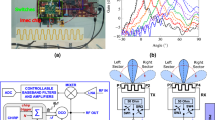Abstract
UWB technology is a useful and safe new technology in the area of wireless body area network. There are many advantages of using UWB as a communication standard for biomedical applications. Due to very low radiated power (−41.3 dBm/MHz), low power consumption, good coexistence with the other existing instruments, Robustness to interference and multipath. Moreover, one specific UWB technology, namely Frequency Modulated (FM)-UWB, has also an important advantage, which make it even more convenient for medical applications, such as simple low cost design (FM, no receive LO, no carrier synchronization as in IR-UWB). UWB technology has been also proposed radar applications such as: Non-Invasive Heart and Respiration Rate Monitoring; Detection of Cardiac Arrhythmias; Detection of Pathological Respiratory Patterns, particularly in Sudden Infant Death Syndrome (SIDS) and Sleep Apnea; Multi-Patient Monitoring; Detection and Non-Invasive Imaging of Breast Tumors. However, pulsed radar are mainly used for these applications. The main issue that is addressed in this paper is the integration of sensing and communication using FM-UWB and radar technology so that a single device can be obtained for two different operational mode. We have show that FM-UWB as radar can meet the requirements of typical biomedical applications such as Non-Invasive Heart and Respiration Rate Monitoring. Advantages and challenges of this integration are shown. Future perspectives of this novel activity will be drawn.
Similar content being viewed by others
References
Varshney, U. (March, 2007). Pervasive healthcare and wireless health monitoring. Mobile Networks and Applications, 12, 113–127.
Arslan H., Chen Z. N., Benedetto M. G. D. (2006) Ultra wideband wireless communication. Wiley., New York
Staderini, E. M. (January, 2002). UWB radar in medicine. IEEE Aerospace and Electronic Systems Magazine, 17(1).
McEwan, T. E. (November, 1996). Body monitoring and imaging apparatus and method. US Patent 5,573,012.
Staderini, E. M. (July, 2008). Oral presentation: Medical applications of UWB radars.
McEwan, T. E., & Azevedo, S. (January/February, 1996). Micropower impulse radar. Science and Technology: Review, 16–29.
Carlos, G. B. (29 November–1 December, 2006). Bio-medical sensing using ultra wideband communications and radar technology: A feasibility study. In First international conference on pervasive computing technologies for healthcare, pp. 1–9.
Staderini, E. M., & Varotto, G. (27–30 November, 2007) Optimization criteria in the design of medical UWB radars in compliance with the regulatory masks. In IEEE conference on biomedical circuits and systems, BIOCAS 2007, pp. 53–58.
Zito, D., Pepe, D., Neri, B., & De, R. D. (4–8 June, 2007). Feasibilty study os a low-cost system-on-a-chip UWB pulse radar on silicon for heart monitoring. In International conference waveform diversity and design, pp. 32–36.
Yang, L., & Giannaki, G. B. (November, 2004). Ultra wideband communication—an idea whose time has come. IEEE Signal Processing Magazine, pp. 26–54.
Gerrits, J. F. M., Farserotu, J. R., & Long, J. R. (21–23 September, 2004). UWB considerations for MAGNET systems. In Thirtieth European conference on solid-state circuits, ESSCIRC-04, pp. 45–56.
Weihua, Z., Shen, X., & Bi, Q. (November, 2003). Ultra-Wideband wireless communications. Wireless Communication and Mobile Computing, 663–685.
Pan, J. (2007). Medical applications of Ultra-WideBand (UWB). Survey Paper.
Thraning, B. M. (July, 2005). The Impact of ZigBee in a Biomedical Environment. Master thesis submitted in Agder University College.
Korhonen, I., & Bardram, J. E. (September, 2004). Guest editorial introduction to the special section on pervaisve healthcare. IEEE Transactions on Information Technology in Biomedicine, 8(3).
Gerrits J. F. M., Kouwenhoven M. H. L., Van der Meer P. R., Farserotu J. R., Long J. R. (2005) Principles and limitations of UWBFM communications systems. EURASIP Journal on Applied Signal Processing 3(6): 382–396
Deliverable: Prototype specification for the FM-UWB and MC-SS RA schemes. PROJECT: MAGNET (My Personal Adaptive Global NET) Beyond, (2006).
Merrill I. Skolnik (2001) Introduction to radar systems. McGraw-Hill, NY, USA
Roberton, M., & Brown, E. R. (2003). Integrated radar and communication based on the Chirped spread-spectrum technique. IEEE MTT-S Digest, pp. 611–614.
Shechter G., Ozturk C., Resar J. R., Mcveigh R. (2008) Respiratory motion of the heart from free breathing coronary angiograms. IEEE Transaction on Medical Imaging 23(8): 1046–1056
Author information
Authors and Affiliations
Corresponding author
Rights and permissions
About this article
Cite this article
Cianca, E., Gupta, B. FM-UWB for Communications and Radar in Medical Applications. Wireless Pers Commun 51, 793–809 (2009). https://doi.org/10.1007/s11277-009-9772-6
Published:
Issue Date:
DOI: https://doi.org/10.1007/s11277-009-9772-6




